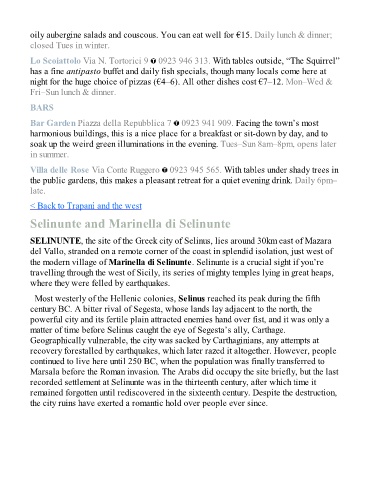Page 535 - The Rough Guide of Sicily
P. 535
oily aubergine salads and couscous. You can eat well for €15. Daily lunch & dinner;
closed Tues in winter.
Lo Scoiattolo Via N. Tortorici 9 0923 946 313. With tables outside, “The Squirrel”
has a fine antipasto buffet and daily fish specials, though many locals come here at
night for the huge choice of pizzas (€4–6). All other dishes cost €7–12. Mon–Wed &
Fri–Sun lunch & dinner.
BARS
Bar Garden Piazza della Repubblica 7 0923 941 909. Facing the town’s most
harmonious buildings, this is a nice place for a breakfast or sit-down by day, and to
soak up the weird green illuminations in the evening. Tues–Sun 8am–8pm, opens later
in summer.
Villa delle Rose Via Conte Ruggero 0923 945 565. With tables under shady trees in
the public gardens, this makes a pleasant retreat for a quiet evening drink. Daily 6pm–
late.
< Back to Trapani and the west
Selinunte and Marinella di Selinunte
SELINUNTE, the site of the Greek city of Selinus, lies around 30km east of Mazara
del Vallo, stranded on a remote corner of the coast in splendid isolation, just west of
the modern village of Marinella di Selinunte. Selinunte is a crucial sight if you’re
travelling through the west of Sicily, its series of mighty temples lying in great heaps,
where they were felled by earthquakes.
Most westerly of the Hellenic colonies, Selinus reached its peak during the fifth
century BC. A bitter rival of Segesta, whose lands lay adjacent to the north, the
powerful city and its fertile plain attracted enemies hand over fist, and it was only a
matter of time before Selinus caught the eye of Segesta’s ally, Carthage.
Geographically vulnerable, the city was sacked by Carthaginians, any attempts at
recovery forestalled by earthquakes, which later razed it altogether. However, people
continued to live here until 250 BC, when the population was finally transferred to
Marsala before the Roman invasion. The Arabs did occupy the site briefly, but the last
recorded settlement at Selinunte was in the thirteenth century, after which time it
remained forgotten until rediscovered in the sixteenth century. Despite the destruction,
the city ruins have exerted a romantic hold over people ever since.

